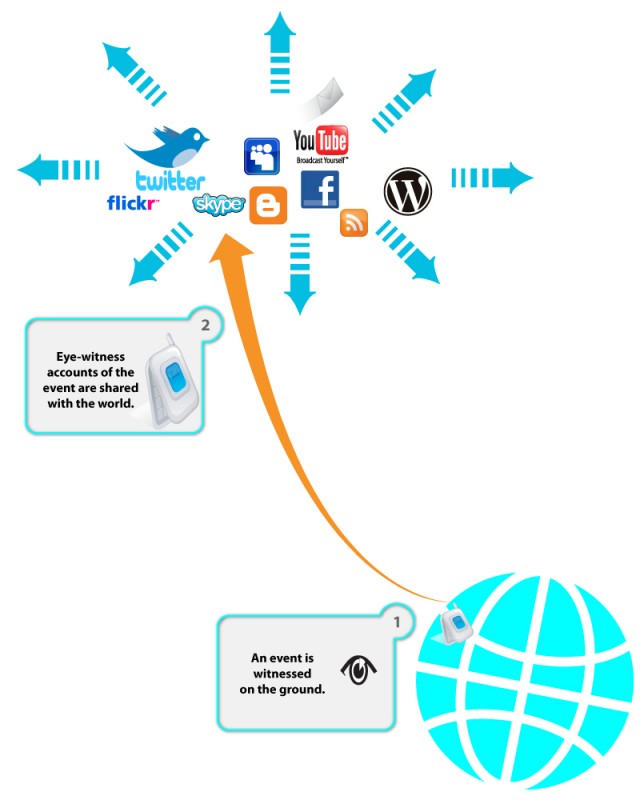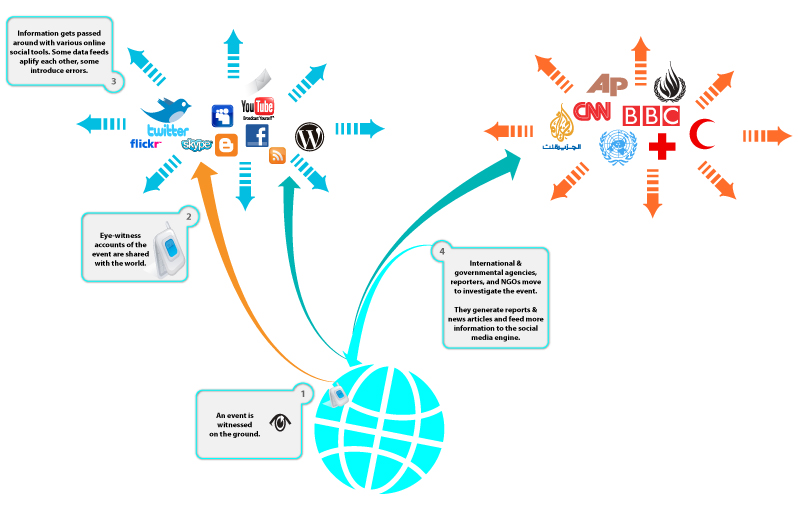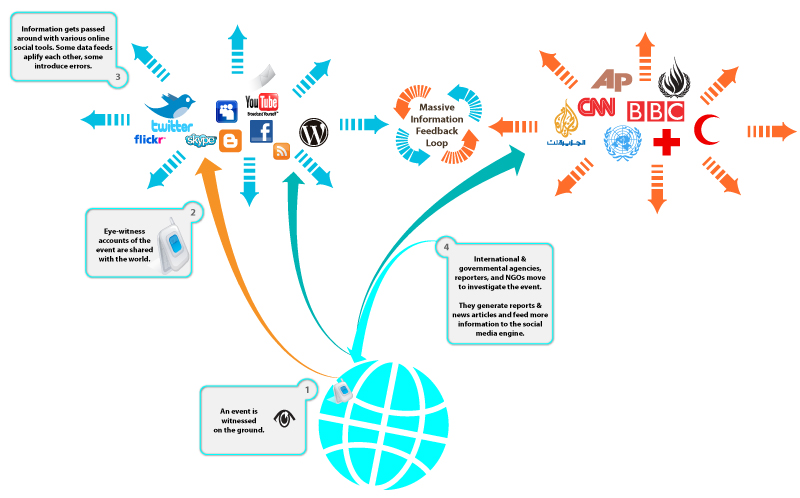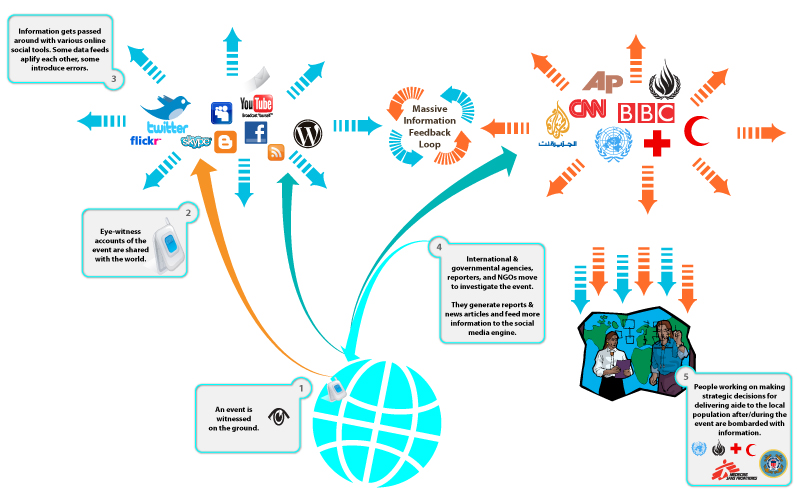I’m working on a series of illustrations to highlight the need for decision scaffolding during an aide mission. The ideas are based on the Ushahidi deployment experience in Haiti after the 2009 earthquake. But the idea is to make this more general. I would love ideas and recommendations on how to make this visualization better and more communicative. (read more about crisis mapping here)
Crisis: Smoke Signals from Eye-Witnesses
Let’s start with a crisis—a natural disaster or a political upheaval leaves thousands of people in desperate need of help. The people on the ground witness the suffering and use ICT (Information Communication Technology) to send up the spoke signals. Please not that Internet services might be compromised (due to deliberate actions taken by the authorities; infrastructure failures; chaotic conditions on the ground), but people tend to be very creative and use phone lines, radios, satellite links, and just person to person communication to get the information out there.

During the current Libyan crisis, people were very creative:
“To avoid detection by Libyan secret police, who monitor Facebook and Twitter, Mahmoudi, the leader of the Ekhtalef (“Difference”) Movement, used what’s considered the Match.com of the Middle East to send coded love letters to rally the revolution”—ABC News article “Muslim Dating Site Madawi Seeds Libyan Revolution” by By Jeffrey Kofman and Ki Mae Heussner. So news gets out!
Crisis: News Coverage and Data Gathering
Once out in the “blogosphere”, the news gets picked up by the news outlets like ABC News, Associated Press, CNN, BBC who send reporters and run articles on the event. At the same time, government agencies, international organization, aide and rescue operations and other NGOs get involved and send in their people and generate their own reports on the crisis.

News organizations and relief agencies make their own contribution to the “blogosphere” as well, amplifying some information, obscuring other. Like in all situations where news gets tossed around, somethings get lost, some get changed. From the point of view of error analysis, it is easy to see how data can get corrupted at this point.

But even with its problems, the massive churning of news creates unprecedented pressure to act in a timely manner:
Mr. Moreno-Ocampo, the ICC Prosecutor, sited Facebook and other social media as key influence in ICC taking action in Libya: “[Facebook and social-networking] triggered a very quick reaction. The [United Nations] Security Council reacted in a few days; the U.N. General Assembly reacted in a few days. So, now because the court is up and running we can do this immediately,” he said. “I think Libya is a new world. How we manage the new challenge—that’s what we will see now.” (CNN World News article: “Gadhafi faces investigation for crimes against humanity” by Atika Shubert (watch the video at 1:40), published on March 3, 2011.) Mr. Moreno-Ocampo talks about sea-change in the world’s reaction time to crisis due to the effects of ICT!
It took years of conflict and a full genocide in Bosnia-Herzegovina before the international community got involved in the Balkans conflict. It only took a few weeks for the world to move in aide of Libya.
Crisis: Strategic Decisions on How to Deliver Help
Decisions on how to best help those in need are usually made in good faith but are hampered by the following:
- extreme time pressure to act—this is the very nature of an emergency (people are buried under rubble, there’s no food or water, there are injured and dead)
- cultural differences—during the disaster, help tends to arrive from the outside and misunderstandings between those in need and those providing it are abound
- incomplete information on the actual conditions on the ground
- compromised infrastructure—low quality maps, inadequate local emergency services, poor disaster preparedness, lack of governmental controls
- time delay in the stream of data—the information takes time to get to decision makers (the more hazardous the conditions on the ground, the longer the delay)
- quantity of data—ICT creates a potential for a fire-hose of information, making the task of processing and analyzing it very time consuming
- quality of data—in an emergency, information tends to come in incomplete, fragmented, and from unreliable sources; in addition, when information gets passed around, mistakes get made
- format of data—information rarely arrives standardized and ready-for-input and in a language understood by the aide group
- background information (maps, emergency codes, contact information, etc.) for the area in crisis might be lacking or inaccessible
- Standard Operating Procedures—each organization has its own way of doing things, thus casting a filter on the incoming data and causing inter-agency conflicts
- competition between service providers—while on the face of it multiple sources of aide is an embarrassment of riches, in practice there’s conflict between the different agencies (for an interesting look on how mental health providers fought over jurisdiction and patients please read an account of 2004 tsunami rescue mission in Ethan Walters’ “Crazy Like Us”.)
So with all the good intentions, aide organizations and aide workers need support structures to make better decisions on how to deliver aide on the ground.

It’s easy to see that the quality of help on the ground depends on the data and its analysis. In an emergency situation, both the data and analysis are weak points. There need to be support mechanisms that comb the data, making it easier to understand. This takes both organization of data and large staff to normalize it for consumption—this is the bottle neck. Currently, this is the weak spot of all crisis aide operations.
Ushahidi and Crowd Sourcing
If you look at the diagrams above, it’s easy to see a natural divide: people working on the ground versus people interacting over the Internet. Many strategic decisions about help are made prior to getting aide works and equipment on the ground. So technology can provide scaffolding to strategic decisions before and during operations on the ground.
There are several obvious avenues for building scaffolding:
- manpower—crowd sourcing can provide manpower for dealing with the fire hose of information: translation services, research for completeness, cross referencing for requests for aide, and simple data entering
- normalization of data—by providing a common tool for ALL organizations to share data, information can be normalized and streamlined (reducing duplication of efforts on the ground)
- quality ranking of information—technology can provide a partial solution to data quality control by ranking the sources of information based on prior experience and pattern matching (this also requires an adaptation of a common tool and data sharing across the various aide providing organizations)
The diagram above shows how crowd sourcing can help manage the data and use tools like Google Earth to provide critical locations on the ground. A small group of dedicated volunteers can serve as a “Control Room” sending queries for translation and clarification and acting as a go-between for hundreds of Internet volunteers and the emergency teams on the ground. A common database with geo-tagged information can become a common ground for all the support organizations, partly negating the problem of “Standard Operating Procedures”, inter-organizational competition, and duplication of efforts. And a data ranking filter can help improve the quality of information and filter out the noise.
It would be difficult to organize such a system on short notice. Fortunately, such a system already exists: “Ushahidi platform is a tool to easily crowdsource information using multiple channels, including SMS, email, Twitter and the web.”
During the 2009 Haiti earthquake disaster, Ushahidi proved a perfect tool for organizing information from eye-witnesses on the ground and combining it with Internet research to deliver reliable data to the rescue operations. CrowdFlower and SamaSource provided manpower to deal with a massive influx of information—translation, geo-tagging, categorization, etc. And a small team of Ushahidi volunteers worked from to review the incoming data and find ways to complete the information to save lives on the ground.
To help improve the quality of data, Ushahidi developed a new product, SwiftRiver: “SwiftRiver is an open source platform that aims to democratize access to tools for filtering & making sense of real-time information.”
Taken in combination, Ushahidi, SwiftRiver, and crowd sourcing can deliver strategic operational support for on the ground operations during natural and man-made disasters.



2 comments for “Decision Scaffolding and Crisis Mapping”